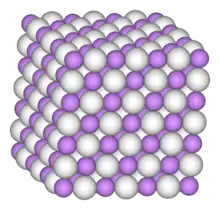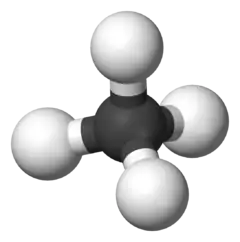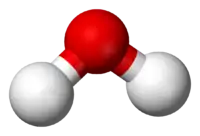Tetraborane
Tetraborane (systematically named arachno-tetraborane(10)) was the first boron hydride compound to be classified by Stock and Messenez in 1912 and was first isolated by Alfred Stock. It has a relatively low boiling point at 18 °C and is a gas at room temperature. Tetraborane gas is foul smelling and toxic.
 | |
| Names | |
|---|---|
| IUPAC names
tetraborane(10) arachno-B4H10 | |
| Identifiers | |
| ChEBI | |
| ChemSpider | |
| UNII | |
| |
| Properties[1] | |
| B4H10 | |
| Molar mass | 53.32 g/mol |
| Appearance | colourless gas |
| Density | 2.3 kg m−3 (gas) |
| Melting point | −120.8 °C (−185.4 °F; 152.3 K) |
| Boiling point | 18 °C (64 °F; 291 K) |
Except where otherwise noted, data are given for materials in their standard state (at 25 °C [77 °F], 100 kPa). | |
| Infobox references | |
History
The class of boranes was elucidated using X-ray diffraction analysis by Lipscomb et. al. in the 1950s. The X-ray data indicated two-electron multicenter bonds. Later, analysis based on high-resolution X-ray data was performed to analyze the charge density.[2]
Structure
Like other boranes, the structure of tetraborane involves multicenter bonding, with hydrogen bridges or protonated double bonds. According to its formula, B4H10, it is classified as an arachno-cluster and has a butterfly geometry, which can be rationalized by Wade's rules.[3] Each boron is sp3 hybridized, and “the configuration of the three hydrogens surrounding borons B1 and B3 is approximately trigonal and suggests approximately tetrahedral hybridization for these borons which would predict bond angles of 120°.”[4]:35 However, the boron arrangements can be classified as fragments of either the icosahedron or the octahedron because the bond angles are actually between 105° and 90°.[4]:3
The comparison of the diffraction data from X-ray diffraction and electron diffraction gave suspected bond lengths and angles: B1—B2 = 1.84 Å, B1—B3= 1.71 Å, B2—B1—B4= 98 ̊, B—H = 1.19 Å, B1—Hμ = 1.33 Å, B2—Hμ =1.43 Å.[4]:3
Preparation
Tetraborane can be produced via a reaction between acid and magnesium, aluminum, or beryillium borides. Hydrolysis of magnesium boride, hydrogenation of boron halides at high temperatures and the pyrolysis of diborane also produce tetraborane. The hydrolysis of magnesium boride was one of the first reactions to give a high yield (14%) of tetraborane. Phosphoric acid proved to be the most efficient acid (other than hydrochloric and sulfuric acid) in the reaction with magnesium boride.
Isomers
Scientists are currently working to produce the bis(diboranyl) isomer of the arachno-tetraborane structure. The bis(diboranyl) is expected to have a lower energy at the Hartree-Fock method (HF) level. There is some evidence that the bis(diboranyl) isomer is initially produced when synthesizing tetraborane by the Wurtz reaction or coupling of B2H5I in the presence of sodium amalgam. Three pathways of conversion from the bis(diboranyl) isomer into the arachno-tetraborane structure have been constructed computationally.
- Path 1: Dissociative pathway via B3H7 and BH3
- Path 2: Concerted pathway over two transition states separated by a local minimum
- Path 3: Another concerted pathway involving penta-coordinated isomers as intermediates
Paths 2 and 3 are more likely, because they are more energetically favored with energies of 33.1 kcal/mol and 22.7 kcal/mol respectively.[5]
Safety
Because it is easily oxidized it must be kept under vacuum. Tetraborane ignites when it comes in contact with air, oxygen, and nitric acid. Boranes in general including tetraborane have been deemed very toxic and are biologically destructive. A study consisting of small daily exposure of the chemical to rabbits and rats resulted in fatality.[6]
References
- Weast, Robert C., ed. (1981). CRC Handbook of Chemistry and Physics (62nd ed.). Boca Raton, FL: CRC Press. p. B-84. ISBN 0-8493-0462-8.
- Förster, Diana; Hübschle, Christian B.; Luger, Peter; Hügle, Thomas; Lentz, Dieter (2008). "On the 2-Electron 3-Center B−H−B Bond: Charge Density Determination of Tetraborane(10)". Inorganic Chemistry. 47 (6): 1874–1876. doi:10.1021/ic701924r. ISSN 0020-1669. PMID 18271535.
- Grimes, Russel N. "Boron." Advanced Inorganic Chemistry. By F. Albert Cotton, Geoffrey Wilkinson, Carlos A. Murillo, and Manfred Bochmann. 6th ed. N.p.: n.p., 1999. 143-46. Print.
- Lipscomb, William N. Boron Hydrides. New York: W. A. Benjamin, 1963. Print.
- Ramakrishna, Vinutha; Duke, Brian J. (2004). "Can the Bis(diboranyl) Structure of B4H10 Be Observed? The Story Continues". Inorganic Chemistry. 43 (25): 8176–8184. doi:10.1021/ic049558o. ISSN 0020-1669. PMID 15578859.
- "Archived copy" (PDF). Archived from the original (PDF) on 2011-07-27. Retrieved 2011-05-11.CS1 maint: archived copy as title (link)
External links
- "Boron»tetraborane (10) [WebElements Periodic Table]". Webelements.com. Retrieved 2017-06-07.
- "Linus Pauling Research Notebooks - Special Collections & Archives Research Center". Osulibrary.orst.edu. Retrieved 2017-06-07.






